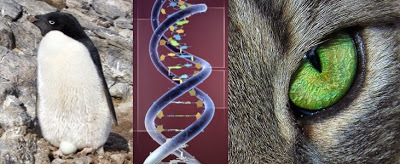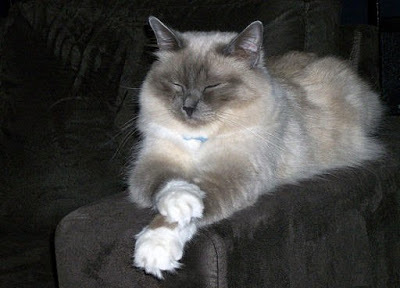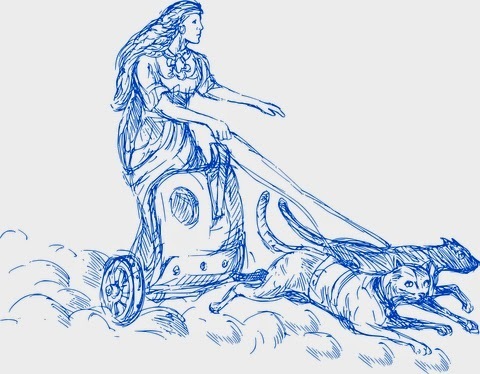Roby Sweet's Blog, page 82
November 19, 2014
Three Cats Take a Bath
Wordless Wednesday

Three cats take a bath.Artist and date unknown.Published by McLoughlin Brothers of New York.Public domain, via Wikimedia Commons.

Three cats take a bath.Artist and date unknown.Published by McLoughlin Brothers of New York.Public domain, via Wikimedia Commons.
Published on November 19, 2014 02:00
November 17, 2014
Review of Home Sweet Mulberry, the New Cat Cozy from Robin G. Austin
 Home Sweet Mulberryis the story of a cat, his person, a helpful ghost, and murder.
Home Sweet Mulberryis the story of a cat, his person, a helpful ghost, and murder.It all starts just after the cat, a British shorthair named Sebastian, and his person, an artistic sort named Sasha Barton, move into an old home in Mulberry, California. The house belonged to Sasha’s grandmother, and Sasha has just inherited it. Apparently, she has also inherited the resident ghost.
His name is Alfred, and he claims to have been the grandmother’s gentleman friend. He also has a “visibility problem,” meaning no one but Sebastian can see him.
Oh, and Sebastian can talk. He doesn’t make meowy sounds that seem like words; he actually talks. He learned this skill by listening so much to his overly talkative human (nothis “owner,” as he keeps reminding Alfred) that one day he could just talk. This is a useful skill for a cat, one that allows him to order up whatever flavor of cat food he prefers on any given day. (Oh, that we all could do that!)
The house is one of those big old homes with a front porch swing and a terrific garden. It is located in a neighborhood described as an “old folks’ haven,” but that doesn’t mean the place is peaceful.
When a dispute between neighbors across the street ends with one of them being knocked out, Sasha runs over to help and gets involved where she probably shouldn’t. That neighbor, Henry DuPont, comes to rather quickly and objects rudely to Sasha’s attempts to help. Soon Sasha and Henry are in a confrontation, and when Henry later turns up dead, there is suspicion that it might have been Sasha who helped him get that way.
Sebastian goes into inspection mode, suspecting every new person he meets—and admittedly, there is a lot of suspicious activity going on. He, Sasha, and Alfred must identify the real killer before that person makes Sasha or Sebastian the next victim.
We enjoyed the concept and story of Home Sweet Mulberry. The relationship between Sasha and Sebastian is truly entertaining, and Sebastian gets his share of laugh-out-loud one-liners. We especially enjoyed Sebastian’s attempts to get Alfred to feed him.
That said, there are some flaws in this book, most (if not all) of which could be fixed by a thorough copyedit. The absence of commas where they are really needed can leave the reader stumbling to find the meaning of a sentence, and there are quite a few typos that we found distracting.
Nevertheless, we thought the story was quite fun. So, with some reservations, I give it

Published on November 17, 2014 02:00
November 14, 2014
What Makes a Cat a Cat? It’s All in the Genes
Miss Cuddlywumps reports on new research into the domestic cat genome
 What makes a cat a cat and not a penguin? The DNA.Illustration by Chocahuète + fichiers commons [GFDL or CC-BY-SA-3.0-2.5-2.0-1.0], via Wikimedia Commons.You are picturing the product of the information contained within the cat’s genes. In that genome, some researchers at Washington University School of Medicine in St. Louis have recently found some interesting things, including evidence of feline domestication and of what sets cats apart from other mammals.
What makes a cat a cat and not a penguin? The DNA.Illustration by Chocahuète + fichiers commons [GFDL or CC-BY-SA-3.0-2.5-2.0-1.0], via Wikimedia Commons.You are picturing the product of the information contained within the cat’s genes. In that genome, some researchers at Washington University School of Medicine in St. Louis have recently found some interesting things, including evidence of feline domestication and of what sets cats apart from other mammals. DNA evidence of (semi-) domesticationCats and humans have been together for “only” 9,000 years or so (compared to the 30,000 or more years since domestic dogs arose from wolves).
Cats, though, “are really only semidomesticated,” according to genetics professor Wes Warren, who was involved in the research. “They only recently split off from wild cats, and some even still breed with their wild relatives. So we were surprised to find DNA evidence of their domestication.”
The researchers compared genomes of domestic and wild cats and found areas where changes have happened apparently as a result of domestication. Changes were found in genes thought to be involved in memory, fear, and reward-seeking, all of which could be important in domestication.
For example, cats might have started hanging around human settlements because of the food (rodents) they found there, and humans might have encouraged them to stay by offering rewards of more food. (And you all know how a cat will hang around once you’ve given it food. That’s how She of Little Talent got one of her real cats, Jack, a former stray who kept hanging around the bird feeder. Now he’s semidomesticated and enjoys crunchy treats and soft blankies.)
As the theory goes, the less fearful cats would hang around more, getting more food rewards and having kittens who learned from a young age to hang around humans and not be terrified of them, until eventually there arose a type of cat whose genome was slightly different from its wild ancestors’.
The Birman’s white glovesThe researchers studied the genomes of some purebred cats, including the Birman. They found that the Birman’s characteristic white paws are linked to two small changes in one gene for hair color. All Birmans have this genetic signature, which could be evidence that humans bred the cats specifically for their adorable little white paws.
 A Birman cat. Note the adorable white paws,a trait related to two small changes on a single gene.Photo by sk_catz [CC-BY-SA-3.0], via Wikimedia Commons.
A Birman cat. Note the adorable white paws,a trait related to two small changes on a single gene.Photo by sk_catz [CC-BY-SA-3.0], via Wikimedia Commons.Cats and tigers have special genes for breaking down fats. This helps the cats, big and small, digest their fatty, all-meat meals.Cats don’t have as many genes for smell as dogs do. They don’t need as many because their hunting technique relies less on scent than on vision and hearing. However, cats have more genes that help them detect pheromones, which help them find mates and keep track of what other cats in the vicinity are up to.Cats have genes that allow them to hear across a greater range than other carnivores (into the ultrasonic range) to help them track prey.Cats have genes for improved low-light vision, important for a hunter on the prowl at dawn and dusk.
The research was published Nov. 10 in the Proceedings of the National Academy of Sciences Early Edition.SourceWashington University in St. Louis.
For more on cat DNA, see “Clues to Cat History Written in DNA” and “Where Purebred Cats Come From”
Published on November 14, 2014 02:00
November 12, 2014
A Cat Watches an Artist at Work
Wordless Wednesday

Poster calendar.Artist: Edward Penfield (1866–1925).New York: R. H. Russell & Son, 1897.Via Library of Congress Prints and Photographs Division.

Poster calendar.Artist: Edward Penfield (1866–1925).New York: R. H. Russell & Son, 1897.Via Library of Congress Prints and Photographs Division.
Published on November 12, 2014 02:00
November 10, 2014
Solving the Murder of the Cat Lady of Ashton Falls
Miss Cuddlywumps reviews Kathi Daley’sTurkeys, Tuxes, and Tabbies
 Looking for a Thanksgiving read filled with mystery, animals, romance, and recipes? Turkeys, Tuxes, and Tabbies might be just what you need. Just don’t expect to get up close and personal with those tabbies.
Looking for a Thanksgiving read filled with mystery, animals, romance, and recipes? Turkeys, Tuxes, and Tabbies might be just what you need. Just don’t expect to get up close and personal with those tabbies.This book is the latest in Kathi Daley’s series of Zoe Donovan mysteries. Zoe runs a rescue and rehabilitation center for domestic and wild animals, which made us like her right away. Given that background, it is no surprise that she gets involved when strange things start happening at the home of the local woman known as the Cat Lady of Ashton Falls.
A neighbor has noticed the many, many cats in Lois’s house have been making an unusual amount of noise. Also, there is no sign of Lois. The initial assumption is that she has run off and left the cats behind, but that hardly makes sense. First, who can imagine a bona fide crazy cat lady doing such a thing? Second, this is a murder mystery, not a person-running-away-from-cats mystery.
It is Zoe who enters the cat-filled home and finds Lois dead—and not from natural causes.
Zoe figures the local sheriff can probably handle this one on his own. The clues seem to be there, plus she already has enough on her plate, what with suddenly having thirty-two cats to find homes for and being secretly engaged to boyfriend Zak, who is about to be “bought” in a bachelor auction. What woman wouldn’t be nervous over the thought of her fiancé falling into the clutches of a beauty who’s willing to pay for his attention?But when it comes down to it, Zoe just can’t mind her own business or stay out of a good investigation. When she discovers that Lois had some secrets, one of which might have gotten her killed, Zoe is all-in. We like that about her.
In fact, Zoe’s character is one of the best things about this book. This is a person who will crawl under a house to rescue some kittens and climb up a trellis to avoid some socialites. She also talks to bears. We like her a lot.
We also enjoyed the community of Ashton Falls, the small town Zoe loves living in. It’s the kind of place where even three feet of snow can’t stop a community dinner. Our one complaint about the setting is that, if there was any mention of the state Ashton Falls is located in, we missed it; this left us feeling a little disoriented as we read.
Turkeys, Tuxes, and Tabbies is an enjoyable read with a solid mystery at its heart. The human characters and relationships are all well-drawn, but we wished for a closer look at the cats, none of whom really stood out as characters or got closely involved in the plot. While this is a good book and certainly worth reading, it’s not our favorite sort of cat cozy in which a feline plays a leading role.
For that reason alone, I give it

Published on November 10, 2014 02:00
November 7, 2014
The Goddess Freya’s Cats
Our subject today is Norse mythology, and specifically the goddess Freya and her cats. And we are not talking about little lap kitties here. No, these cats were powerful creatures who pulled the goddess’s chariot.
The goddess Freya and her cats
 The Norse goddess Freya in her chariot pulled by two blue cats.© Patrimonio | Dreamstime.com - Freya Norse Goddess PhotoFreya (or Freyja) was a fertility goddess and was associated with domesticity, womanhood, and female sexuality. She was also associated with sorcery and magic, as well as war and death. It was said that after a battle, Freya would lead a band of Valkyries to gather the fallen warriors—or half of them, at least. She would take her share of the dead to Folkvang, her hall in the home of the gods, while the other half went to Odin, god of wisdom and war. Freya might also have been the goddess on hand to greet women after death.
The Norse goddess Freya in her chariot pulled by two blue cats.© Patrimonio | Dreamstime.com - Freya Norse Goddess PhotoFreya (or Freyja) was a fertility goddess and was associated with domesticity, womanhood, and female sexuality. She was also associated with sorcery and magic, as well as war and death. It was said that after a battle, Freya would lead a band of Valkyries to gather the fallen warriors—or half of them, at least. She would take her share of the dead to Folkvang, her hall in the home of the gods, while the other half went to Odin, god of wisdom and war. Freya might also have been the goddess on hand to greet women after death.Freya’s chariot was pulled not by horses but by two male cats. Both cats were described as being blue or gray and had been a gift from Thor.
Why cats? Well, cats have been associated with femininity and fertility since ancient Egypt, so it isn’t surprising that cats would be associated with Freya in Norse mythology. But if Freya was the goddess of the feminine, why were her cats male? It may be that the association of Freya and these male cats represented a combination of female and male sexuality (Prehal, p. 16).
Thor gives Freya two blue kittensAccording to a Russian tale based on Norse stories, Freya’s cats were a gift from Thor.
One day while Thor was fishing, he heard a beautiful singing that lulled him to sleep. Soon enough, though, he was awakened by a horrible noise. Irritated, he went in search of the noise and came upon the magic Cat Bayun and two blue kittens. The kittens were asleep, and the cat, a male, was singing to them.
Thor asked if Cat Bayun was the kittens’ father, and the cat replied that he was. He’d met a pretty female in the spring and together they’d had these kittens, but now their mother had left him and he was stuck as a single father. He asked for Thor’s help, and Thor got the idea to give the kittens to Freya.
Bayun then turned into a bird and flew away, and Thor gathered up the kittens and took them to Freya. Those kittens grew into the cats that pulled Freya’s chariot. SourcesPrehal, Brenda. Freyja’s Cats: Perspectives on Recent Viking Age Finds in Þegjandadalur North Iceland. Master’s thesis. Hunter College of the City University of New York. 2011.
The Encyclopedia of Ancient Myth and Culture. London: Quantum Books, 2003.
The Facts on File Encyclopedia of World Mythology and Legend. 2nd ed. Vol. I. New York: Facts on File, 2004.
Published on November 07, 2014 02:00
Roby Sweet's Blog
- Roby Sweet's profile
- 7 followers
Roby Sweet isn't a Goodreads Author
(yet),
but they
do have a blog,
so here are some recent posts imported from
their feed.



